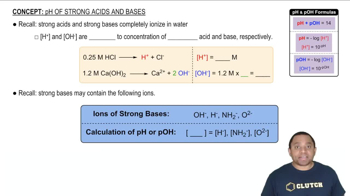Predict whether aqueous solutions of the following substances are acidic, basic, or neutral: (c) NaClO
Ch.16 - Acid-Base Equilibria
Chapter 16, Problem 89
Predict which member of each pair produces the more acidic aqueous solution: (a) K+ or Cu2+ (b) Fe2+ or Fe3+ (c) Al3+ or Ga3+.
 Verified step by step guidance
Verified step by step guidance1
Step 1: Understand the concept of acidity in aqueous solutions. Acidity in aqueous solutions is often related to the ability of a cation to polarize water molecules, leading to the release of protons (H+). This is influenced by the charge density of the cation.
Step 2: Analyze the charge and size of the cations. Higher charge and smaller ionic radius generally increase the charge density, making the cation more effective at polarizing water molecules and thus more acidic.
Step 3: Compare the cations in each pair based on their charge and size. For example, between K+ and Cu2+, Cu2+ has a higher charge and likely a smaller radius, making it more acidic.
Step 4: Apply the same analysis to the other pairs. For Fe2+ vs. Fe3+, Fe3+ has a higher charge, and for Al3+ vs. Ga3+, consider the periodic trends and charge density.
Step 5: Conclude which cation in each pair is more acidic based on the analysis of charge density and polarization ability.
Key Concepts
Here are the essential concepts you must grasp in order to answer the question correctly.
Acidity and pH
Acidity refers to the concentration of hydrogen ions (H+) in a solution, which determines its pH level. A lower pH indicates a more acidic solution. Understanding how different ions affect the concentration of H+ is crucial for predicting the acidity of solutions.
Recommended video:
Guided course

pH of Strong Acids and Bases
Cation Charge and Hydrolysis
Cations can influence the acidity of a solution through hydrolysis, where they react with water to produce H+ ions. Generally, cations with higher positive charges, such as Cu2+ and Fe3+, tend to hydrolyze more significantly than those with lower charges, leading to increased acidity.
Recommended video:
Guided course

Formal Charge
Comparative Analysis of Metal Ions
When comparing metal ions, factors such as charge density and the ability to stabilize the resulting hydroxide ions play a role in acidity. For instance, smaller, highly charged ions like Al3+ are more acidic than larger, less charged ions like Ga3+, due to their stronger attraction to water molecules and greater tendency to release H+.
Recommended video:
Guided course

Dimensional Analysis
Related Practice
Textbook Question
1
views
Textbook Question
Predict whether aqueous solutions of the following substances are acidic, basic, or neutral: (d) 3CH3NH34NO3
Textbook Question
Predict whether aqueous solutions of the following substances are acidic, basic, or neutral: (e) Na2SO3.
Textbook Question
Which member of each pair produces the more acidic aqueous solution: (a) ZnBr2 or CdCl2 (b) CuCl or Cu(NO3)2 (c) Ca(NO3)2 or NiBr2
Textbook Question
An unknown salt is either NaF, NaCl, or NaOCl. When 0.050 mol of the salt is dissolved in water to form 0.500 L of solution, the pH of the solution is 8.08. What is the identity of the salt?
Textbook Question
An unknown salt is either KBr, NH4Cl, KCN, or K2CO3. If a 0.100 M solution of the salt is neutral, what is the identity of the salt?
